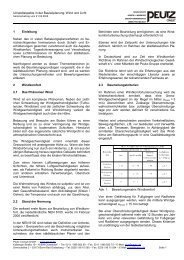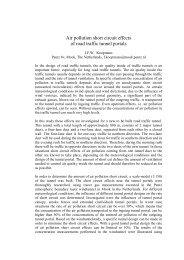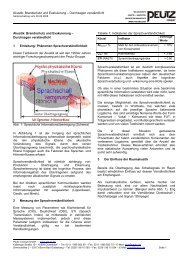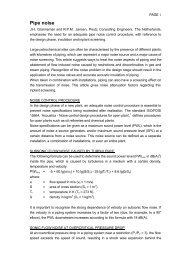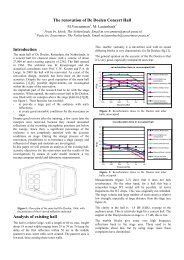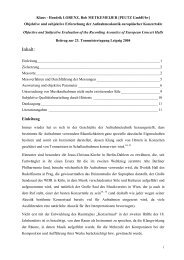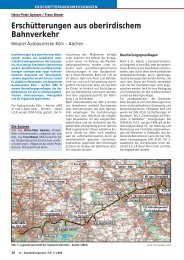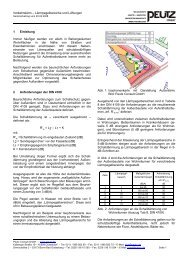Whistling Building Objects, Origins and Solutions - Peutz.co.uk
Whistling Building Objects, Origins and Solutions - Peutz.co.uk
Whistling Building Objects, Origins and Solutions - Peutz.co.uk
You also want an ePaper? Increase the reach of your titles
YUMPU automatically turns print PDFs into web optimized ePapers that Google loves.
Therefore a test grating was designed, of which the<br />
distances <strong>co</strong>uld be varied without changing other<br />
parameters. Based on <strong>co</strong>mmon practice a thickness<br />
of 2 mm for the (galvanized) steel of the bearing<br />
bars has been used.<br />
Sharp edges of the steel bearing bars have been<br />
used since practice showed that rounding the edges<br />
decreases the generated sound levels.<br />
MEASUREMENT SET UP<br />
In the a<strong>co</strong>ustical laboratory of <strong>Peutz</strong> in Mook<br />
“silent air” is available. For this specific research<br />
the velocity of the air flow was variable from 0 up<br />
to about 30 m/s.<br />
Figure 3 shows the test grating designed to<br />
determine the influence of height <strong>and</strong> distance<br />
between bearing bars, as well as the sharpness of<br />
the edges <strong>and</strong> the angle of attack of the air flow.<br />
The distance between bearing bars <strong>co</strong>uld be<br />
changed with intervals of 1 cm. The height of the<br />
studied bearing bars is 20, 30 en 40 mm. When at a<br />
certain air velocity an aeolian tone is observed for<br />
the first time, the angle of attack is changed in<br />
small steps.<br />
Figure 3: The test grating<br />
MEASUREMENT RESULTS<br />
In figure 4 measurement results regarding the test<br />
grating with bearing bars with a height of 40 mm<br />
<strong>and</strong> varying center to center (c.t.c.) spacing of<br />
bearing bars of respectively 30, 40, 50 en 60 mm<br />
are shown. The angle α of the air flow in this<br />
specific case is 26°, at which the aeolian tone is at<br />
its loudest. In the following only some<br />
representative results regarding this phenomena are<br />
presented.<br />
Figure 4a shows a clear peak at an air flow of 27<br />
m/s in the 3150 Hz third-octave b<strong>and</strong>. At an air<br />
flow velocity of 25 m/s two peaks are observed, in<br />
the 3150 <strong>and</strong> 10000 Hz third-octave b<strong>and</strong>s. These<br />
tones alternate in time, as can be seen from figure 5,<br />
showing the sound spectra as function of time.<br />
Figure 4a-d: Measurements on the test grating with a bar<br />
height of 40 mm.<br />
Figure 5: Spectral sound power levels as function of time<br />
for grating with bearing bars height / distance of 40 mm /<br />
30 mm at an air velocity of 25 m/s<br />
With air flow velocities below 20 m/s no tone is<br />
observed anymore. At c.t.c. spacing of respectively<br />
50 <strong>and</strong> 60 mm no tone at higher frequencies is<br />
observed; see figures 4c <strong>and</strong> 4d. This also applies to<br />
other angles of attack.<br />
Figure 6 deals with an angle α = 26°. Figure 6b<br />
gives the results with the grating tilted to 38°.<br />
Figure 6a shows a clear peak in the 3150 Hz thirdoctave<br />
b<strong>and</strong>, at air flows from 27 to 23 m/s with no<br />
significant change in sound level. At 22 m/s the<br />
tone disappears. At 16 m/s two tones are observed<br />
in the 3150 <strong>and</strong> 6300 Hz third-octave b<strong>and</strong>s with a<br />
relative low sound level.



